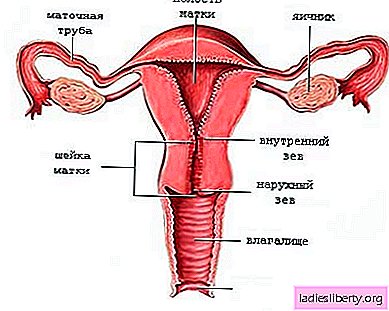
Cervical erosion - a pathological change in the epithelial layer of the cervix, having a benign character. Many women today are faced with this problem. As a rule, erosion does not present a serious health hazard if the process is not in an advanced stage. This fact does not give the right to believe that treatment is optional.
Erosion - Causes
In some cases, the reasons remain unclear. However, most often, factors such as:
- transferred inflammatory or chronic diseases of the female genital and pelvic organs, as well as STDs;
- microtrauma of the cervix due to abortion or childbirth;
- violation of hormonal balance, menstrual cycle;
- Decrease in body defenses, the transferred stresses.
Many experts argue that erosion can occur as a birth defect.
Erosion - Symptoms
The disease is congenital and acquired. Congenital and minor defects are overwhelmingly asymptomatic. And only a doctor at a routine examination can detect erosion.
Sometimes the signs are quite vivid and palpable. Erosion can manifest itself in the form of pulling dull pains in the lower abdomen, discomfort in the vagina, profuse or spotting spotting.
Erosion makes a woman vulnerable to various infections. The damaged epithelial layer serves as an “entrance gate” for pathogenic bacteria and microorganisms. The likelihood of transmission of sexually transmitted diseases, including HIV infection, is increasing.
During pregnancy, erosion can cause premature opening of the uterus, leading to miscarriage or early childbirth.
The most formidable complications of this defect can be infertility and the development of a malignant tumor.
Erosion - Diagnosis
Visual diagnosis is carried out by a gynecologist with the help of a colposcope device, which allows you to examine the affected area in a 30-fold increase.
To confirm the diagnosis, a biopsy is performed (the most reliable and informative method to date).
If erosion is detected, it is mandatory to undergo an additional examination for the presence of sexually transmitted infections: trichomoniasis, herpes, chlamydia, ureaplasmosis, etc., as well as take tests for HIV and syphilis.
Diagnosis of erosion and possible concomitant infections will allow the doctor to navigate and choose the right treatment tactics.
Erosion - treatment and prevention
Chemical removal - exposure to an erosive area with chemicals, usually Solkovagin is used for the procedure. This method is suitable for minor deviations and shallow lesions.
Cauterization is a radical, but, on the other hand, effective method. Erosion is cauterized by an electrocoagulator, which can destroy the focus through high temperature.
Liquid nitrogen treatment (cryotherapy) is widely used in the treatment of the disease. The advantage of the low-temperature method is that the healing process goes without scars, and the cervix does not lose elasticity, this is important in future births.
Operational method. The scalpel becomes the weapon of oncologists if erosion is transformed into a malignant tumor. This happens quite rarely. After surgery, the woman undergoes chemotherapy - only in this way is a complete cure possible.
The use of a surgical laser is the most effective, efficient and painless method to date. Provides tissue preservation, high accuracy of treatment and quick healing without scarring.
In the process of treatment, a woman needs careful monitoring by a gynecologist. In the recovery period, she is not recommended to lift weights, overwork and engage in sexual relations.
As preventive measures, it is necessary to observe hygiene, keep the genitals clean.
Also, do not forget to visit the gynecologist once every six months. Do not lead a promiscuous sex life, as a frequent change of partners contributes to a change in the microflora of the vagina, the risk of erosion increases. Protect yourself from unwanted pregnancy, as abortion negatively affects the health of women and all genital organs.











